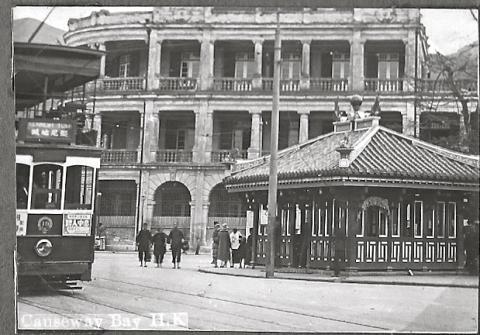In 1928 we left Happy Valley and went to live at Braemar
Terrace, Quarry Point. This was a new terrace of flats, two-storeyed
with a flat roof, as in most Hong Kong houses. Ours was an
upstairs flat with stairsup to the open roof, where our washing
was hung to dry, and where the servants kept their pot plants.
They lived in rooms that opened on to the roof at the back. The
roof was open from one end to the other, and it was a pleasant place
to walk and enjoy the view, which was a spectacular one over the
eastern end of the harbour, looking towards Kowloon Peak and
Lion Rock and the chain of hills. Away to the left was the busy
part of the harbour at Victoria and Kowloon, and to the right
Lyemun Pass. Our part of the harbour was relatively empty
with usually only junks, sampans and the occasional steam launch
to be seen. It was quite a climb up the path to Braemar from the
main road down by the waterfront. Along this road ran the tramway,
passing by Quarry Bay and the Taikoo Dockyard, andending at
Shaukiwan, in the east. And westwards was the road we took to
town and to our offices, passing Causeway Bay, where the sampans
and junks anchored. In the mornings our amah used to wake us
at seven. We had to leave in good time, to be at our offices at nine.
Causeway Bay Tram
In another flat lived Molly and Ken Oliver, of Butterfield and Swire
and their young daughter Phyllis. They became two of our best friends.
At first we had two amahs at Braemar Terrace. The cook amah was
unusually tall for a Cantonese, and we called them High Jinks and
Low Jinks,
Later High Jinks left us, and a cook boy took her place. He was a
magnificent cook. His "chicken and rice" embellished with almonds and
raisins was a masterpiece of the art of Chinese cooking. Our
remaining amah's name was Ah Ha. She was a tiny, faithful woman
who became one of the family and was dear to us. She had a
daughter Wen Ching who sometimes came to stay with her, and a son
whom she called "Ma Booey" (my boy), also a large contented cat
that she kept chained up at the top of the stairs, and the usual
canary.
An Amah was addressed as Ah Sam if you did not know her name.
Men servants were called Boy (not because they were young!). Large
establishments like the bachelors' messes (houses that the bachelors
shared) and Government House employed several boys, and the senior
was the Number One Boy, addressed as "Number One", if not by his
own name. Coolies were young men who cleaned the house.
Sometimes young relatives of the servants came into our houses to
train to be amahs, boys or coolies. They were known as
"makee learn".
Like all Amahs, Ah Ha wore a white jacket, buttoned up high in the
neck, and shiny black trousers, her smooth black hair drawn back
from her forehead with hairpins in her bun at the back, and earrings.
She always looked the essence of neatness, as all the Chinese women
did. The servants never took holidays, except to visit the ancestral
home; in Hong Kong this was always called by them "Canton more
far", and in Shanghai "Ningpo more far". On these occasions they
found a substitute to work for us while they were away. Wen Ching
came to us sometimes.
Ah Ha cooked her food over a charcoal stove made of earthenware
and studded with large holes. It stood on the ground and she
would squat beside it, cooking her rice and fish and vegetables,
occasionally fanning the coals to keep up the heat. Audrey and I
were often offered pieces of the hard, crackly rice that had stuck to
the bottom of the pan.
At Chinese New Year Ah Ha used to give Audrey and me "lucky
money", a coin wrapped in special red paper, usually a Chinese
cash with a square hole in the middle, but sometimes a Hong
Kong coin with the King's head, and we all wished each other
"Kung hay fat choy" - happy New Year.
Chinese New Year was a festive time. The holiday lasted for several
days. Fire crackers could be heard all day long and into the night,
and the Chinese wore their best clothes and went visiting each
other.
Audrey and I were allowed to go to the New Year market at last.
It was gay with the sound of Chinese music and the chatter of the
crowds. Everything imaginable was sold at the stalls, the most
memorable for me being those New Year flowers, the long branches
of hanging bells, enkianthus; and the ornamental bowls of narcissi
growing in pebbles and water. Their haunting fragrance could
never be forgotten.
